Tomlinson B.R. The New Cambridge History of India, Volume 3, Part 3: The Economy of Modern India, 1860-1970
Подождите немного. Документ загружается.

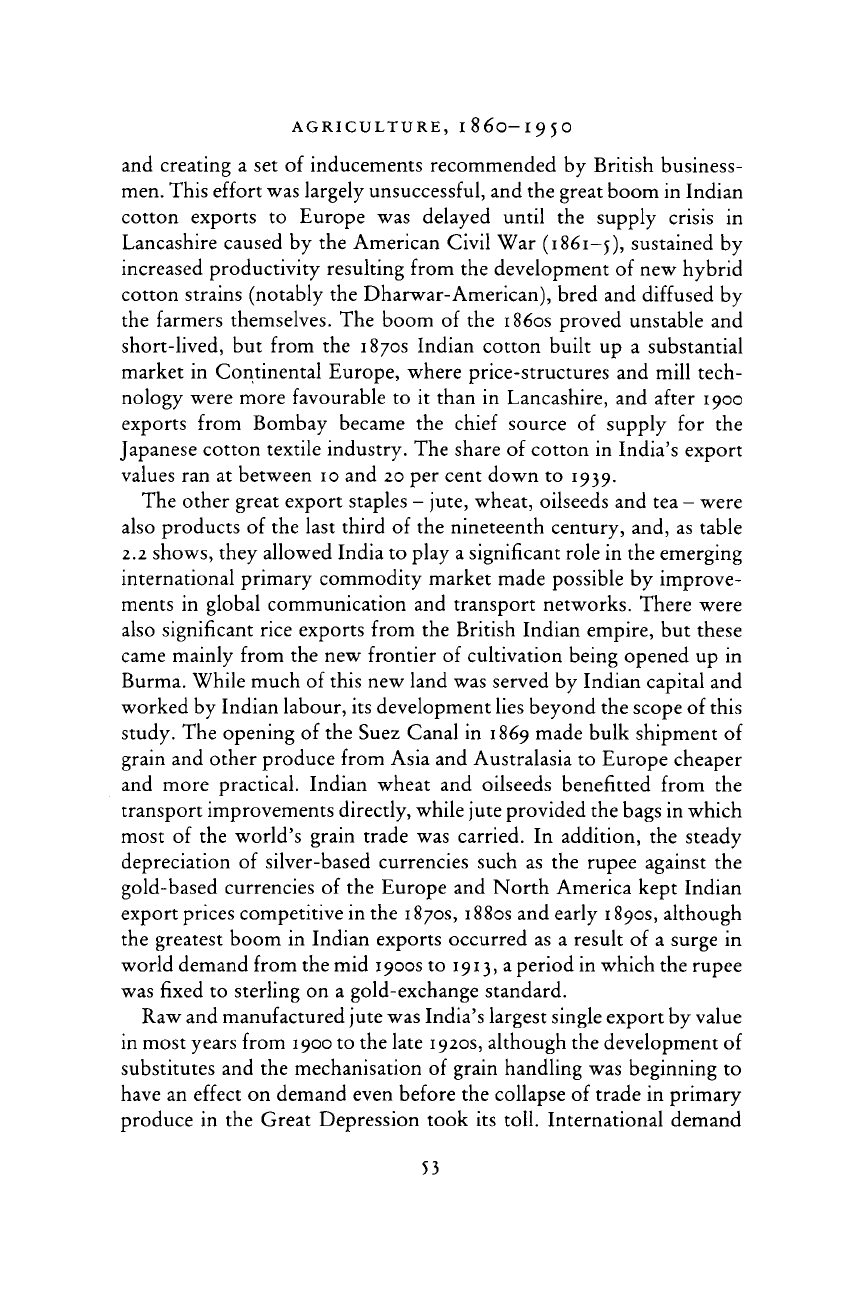
AGRICULTURE,
1860-I95O
53
and creating a set of inducements recommended by British business-
men. This effort was largely unsuccessful, and the great boom in Indian
cotton exports to Europe was delayed until the supply crisis in
Lancashire caused by the American
Civil
War
(1861-5),
sustained by
increased productivity resulting from the development of new hybrid
cotton
strains
(notably the Dharwar-American), bred and diffused by
the farmers themselves. The boom of the
1860s
proved unstable and
short-lived, but from the
1870s
Indian cotton built up a substantial
market in Continental Europe, where price-structures and mill tech-
nology
were more favourable to it
than
in Lancashire, and after 1900
exports from Bombay became the
chief
source of supply for the
Japanese
cotton textile industry. The
share
of cotton in India's export
values
ran at between 10 and 20 per cent down to
1939.
The
other great export staples - jute, wheat, oilseeds and tea - were
also products of the last
third
of the nineteenth century, and, as table
2.2
shows, they allowed India to play a significant role in the emerging
international primary commodity market made possible by improve-
ments in global communication and
transport
networks. There were
also significant rice exports from the British Indian empire, but these
came mainly from the new frontier of cultivation being opened up in
Burma. While much of this new land was served by Indian capital and
worked
by Indian labour, its development lies beyond the scope of this
study. The opening of the
Suez
Canal in
1869
made bulk shipment of
grain and other produce from
Asia
and Australasia to Europe cheaper
and more practical. Indian wheat and oilseeds benefitted from the
transport
improvements directly, while jute provided the bags in which
most of the world's grain
trade
was carried. In addition, the steady
depreciation of silver-based currencies such as the rupee against the
gold-based currencies of the Europe and North America kept Indian
export prices competitive in the
1870s,
1880s
and early
1890s,
although
the greatest boom in Indian exports occurred as a result of a surge in
world
demand from the mid
1900s
to 1913, a period in which the rupee
was
fixed
to sterling on a gold-exchange
standard.
Raw
and manufactured jute was India's largest single export by value
in most years from 1900 to the late
1920s,
although the development of
substitutes and the mechanisation of grain handling was beginning to
have an
effect
on demand even before the collapse of
trade
in primary
produce in the Great Depression took its toll.
International
demand
Cambridge Histories Online © Cambridge University Press, 2008
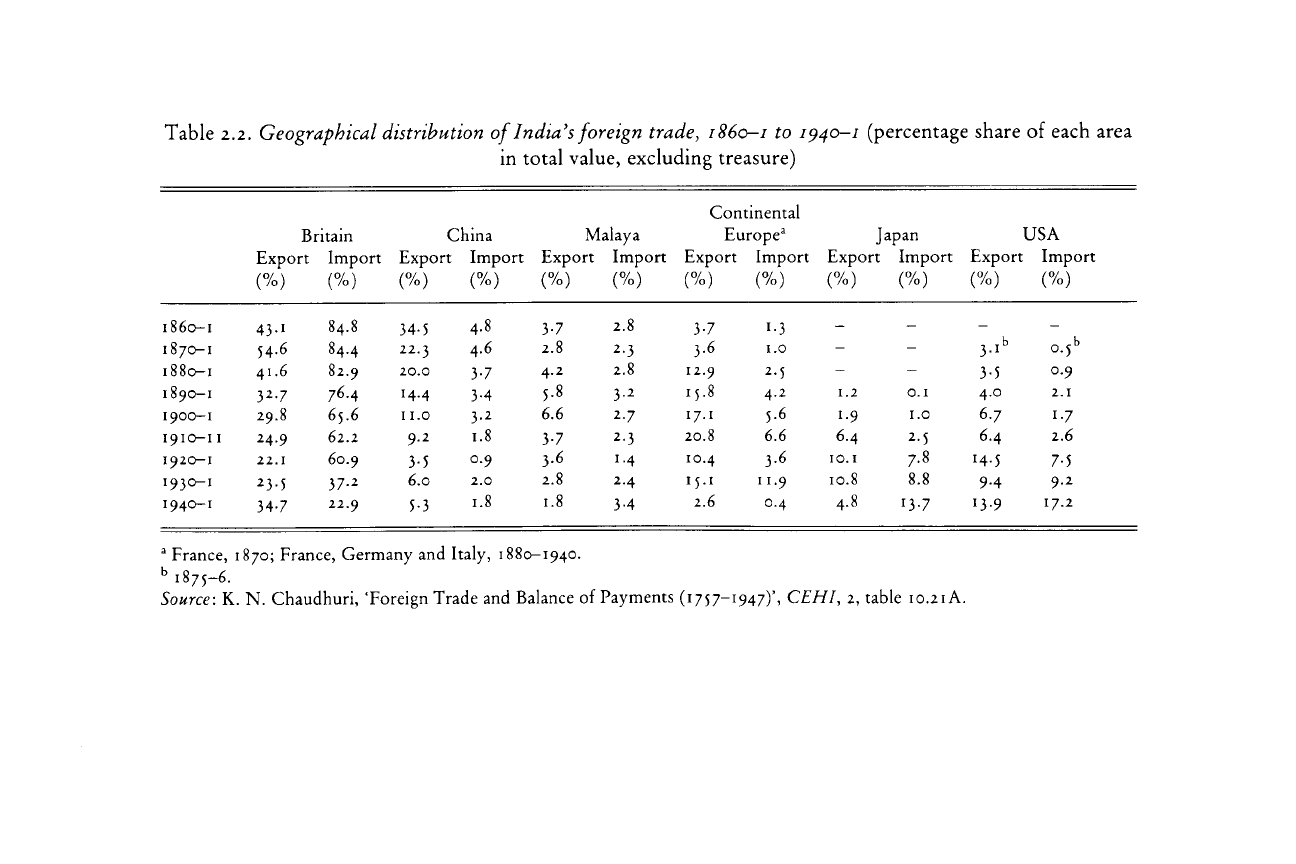
Table
2.2. Geographical distribution of India's foreign trade, 1860-1 to 1940-1 (percentage share of each area
in total value, excluding treasure)
Continental
Britain
China
Malaya
Europe
3
Japan
USA
Export
Import
Export
Import
Export Import
Expo
rt Import Export
Import
Export Import
(%)
(%)
(%)
(%)
(%)
(%)
(%) (%)
(%) (%)
(%)
(%)
1860-1
43-i
84.8
34-5
4.8
3-7
2.8
3-7
!-3
- - - -
1870-1
54.6
84.4
22.3 4.6
2.8
2-3
3.6
1.0
- -
3-i
b
o-5
b
1880-1
41.6
82.9
20.0
3-7
4-2
2.8
12.9
2
-5
- -
3-5
0.9
1890-1
32.7
76.4
14.4
3-4
5.8
3-
2
15.8
4-
2
1.2 O.I
4.0 2.1
1900-1
29.8 65.6
11.0
3-
2
6.6
2
-7
17.1
5.6
i-9
1.0
6.7
i-7
1910-1i
24.9
62.2
9-2
1.8
3-7
2
-3
20.8 6.6
6.4
2
-5
6.4
2.6
1920-1
22.1
60.9
3-5
0.9
3.6
i-4
10.4
3.6
10.i
7.8
!45 7-5
1930-1
¿3-5
37-2
6.0
2.0
2.8
2
-4
15.i
11.9
10.8 8.8
9-4
9-2
1940-1
34-7
22.9
5-3
1.8
1.8
3-4
2.6
0.4
4.8
13-7
x
3-9
17.2
a
France, 1870; France, Germany and Italy, 1880-1940.
b
1875-6.
Source: K. N. Chaudhuri, 'Foreign Trade and Balance of Payments
(1757-1947)',
CEHI, 2, table
10.21A.
Cambridge Histories Online © Cambridge University Press, 2008

AGRICULTURE,
1860-1950
55
for
Indian wheat was intermittent, especially as internal transport
difficulties
and other costs meant
that
its domestic price was usually
above
that
on the world market; however, when harvests failed
elsewhere
in the world India could be an important supplier, and
provided nearly 18 per cent of Britain's total wheat imports between
1902
and
1913.
The Government of India placed an embargo on wheat
exports during the First World War because of worries about food
availability,
and the export trade did not revive in the glutted inter-
national market of the 1920s. Indian competitiveness in oilseeds was
more assured, and by 1914 she was the world's largest supplier of
rapeseed and groundnuts, much of which went to the expanding
margarine industry of continental Europe (notably France). Tea also
benefitted from transport improvements, and from a phenomenal
growth
in demand in Europe and North America, associated with
rising real living standards for the mass of the population. By the early
twentieth century, the effect of these changes had been to alter
fundamentally many of the main lines of communicatibn and econmic
exchange
inside the subcontinent, creating a new pattern of agrarian
activity
focused on the port-cities of Calcutta, Bombay, Karachi and
Madras, and their hinterlands, as shown in map 2.3.
22
The
expansion of Indian exports was assisted by the extension of
domestic trade and transport networks, notably the building of
railways
after 1850. The first railway line was laid out of Bombay in
1853,
followed by others from Calcutta
(1854)
and Madras
(1856);
then
there was a patchwork process of construction, much of it initially for
strategic purposes, culminating in the building of the main trunk-line
network inland from the major port cities in the 1880s. By 1910 India
had the fourth-largest railway system in the world. In i860 there were
about 850 miles of track open in the subcontinent, 16,000 by 1890,
3
5,000
by 1920 and
40,000
by
1946,
which meant
that
78 per cent of the
total land area was no more than 20 miles from a railway line. Map 2.4
shows
full extent of the colonial railway network of the early 1930s.
The
quantity of freight carried increased from 3.6 million tonnes in
1871,
to 42.6 million in 1901, to 116 million in 1929-30 and to 143.6
million
in
1945-6.
22
The
concept
of the
spatial
reorganisation
of
India
in the
colonial
period
is
taken
from
David
E.
Sopher,
'The
Geographical
Patterning of Culture in India', in
David
E.
Sopher
(ed.),
An
Exploration of India:
Geographical
Perspectives
on
Society
and
Culture,
London, 1980,
%
9-
Cambridge Histories Online © Cambridge University Press, 2008
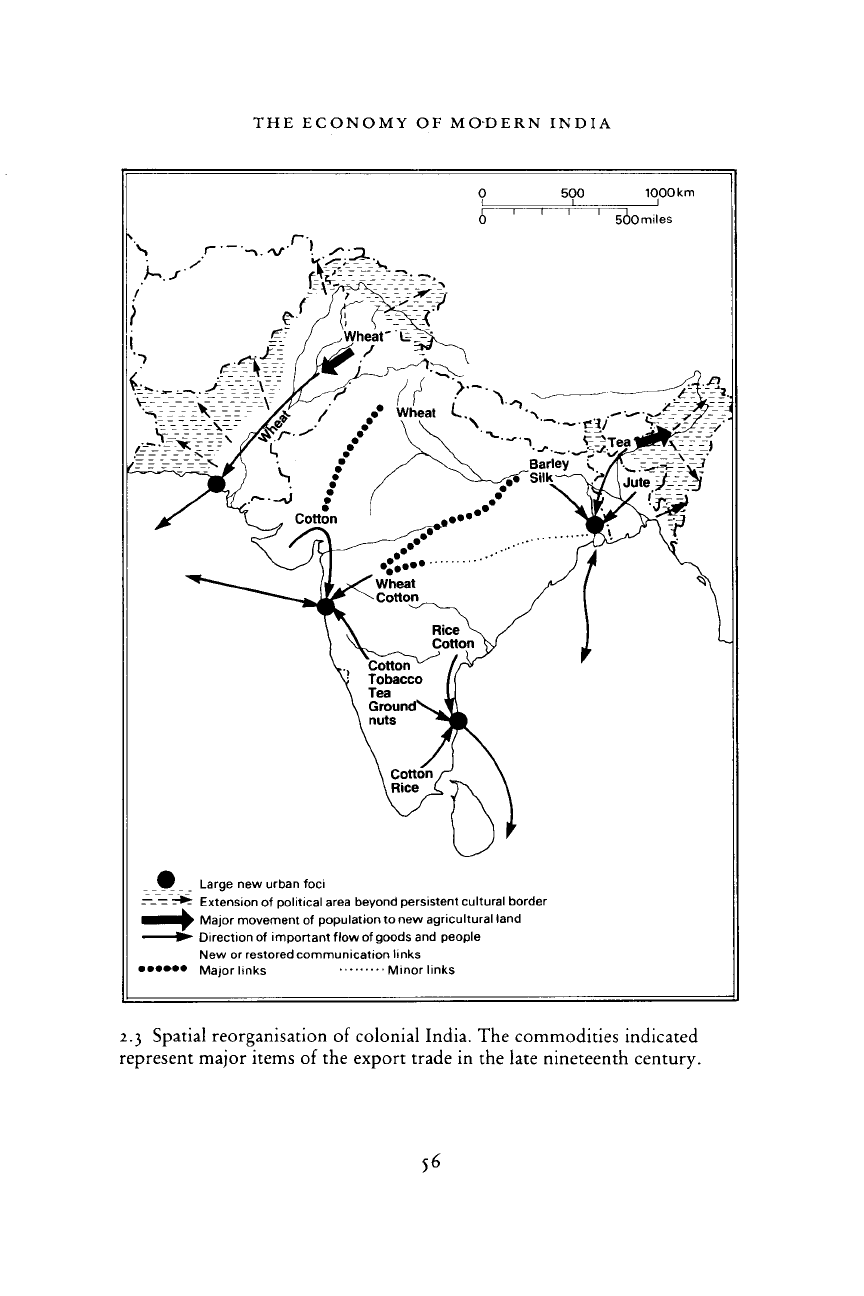
THE
ECONOMY
OF MODERN INDIA
0 500 1000km
6 ' ' ' ' 500 miles
~-~= Extension of political area beyond persistent cultural border
HHI^ Major movement of population to new agricultural land
^ Direction of important flow of goods and people
New or restored communication links
•••••• Major links Minor links
2.3 Spatial reorganisation of colonial
India.
The commodities indicated
represent
major items of the export
trade
in the late
nineteenth
century.
56
Cambridge Histories Online © Cambridge University Press, 2008

2.4 Main-line railways, с. 1947
Cambridge Histories Online © Cambridge University Press, 2008

THE
ECONOMY OF MODERN INDIA
The
Indian railways certainly provided quicker and cheaper trans-
port
than
had been available hitherto. One estimate has suggested
that
freight-rates per ton mile on the railways in 1930 were 94 per cent less
than
the charges for pack-bullocks in 1800-40, and 88 per cent less
than
those for bullock carts in 1840-60, creating a 'social saving' of about 9
per cent of national income. This saving does not represent the
true
developmental effect of the railways, however, since the countervailing
costs of state subsidies for capital and the weakness of the linkage
effects
between the railways and other
transport
networks in the
economy
must also be taken into account.
23
Furthermore, the initial
siting of the network cut across existing
trade
routes, and gave
significant
advantages to commerce with the port cities and the foreign
trade
sector. Even on the best routes neither the efficiency nor the costs
of
the service compared favourably with the railway systems of India's
major international competitors. By the 1900s the system was severely
undercapitalised, leading to delays in shipment, slow
trains
and
obsolete rolling stock. The First World War put new strains on railway
capacity,
since India also supplied equipment for the military cam-
paigns in Palestine and Iraq, and financial stringency and managerial
weakness limited capital investment to solve the problems in the
post-war years. By the 1920s the railway system was subjected to
further fiscal controls, and in every year from 1926 to 1931 sharp
increases in rates were accompanied by a decline in the volume of
goods
shipped.
24
Opportunities for expanded crop production for sale at home or
abroad increased in the last third of the nineteenth century, and
exercised
a major influence on the rural economy from about 1870
until the late 1920s. A convenient description of the principal crops of
colonial
South
Asia
in the early twentieth century is given in the Report
of
the Royal Commission on Agriculture in India (1928):
For the benefit of
readers
who may be
unacquainted
with
Indian
conditions, it may
be explained
that
throughout
northern
India,
the Central Provinces and the
greater
part
of the Bombay Presidency,
there
are two well defined
crop
seasons, the
rainy
and the cold, yielding two
distinct
harvests,
the
autumn
or
kharif
and the
spring
or
rabi.
In the
south
of the
peninsula,
the
greater
part
of which gets the benefit of the
23
John M. Hurd, 'Railways',
CEHI,
11,
pp.
740-1.
24
Ibid.,
pp.
756-8.
58
Cambridge Histories Online © Cambridge University Press, 2008

AGRICULTURE,
1860-1950
north-east
monsoon from October to
January
and in which the extremes of
temperature
are
absent,
the distinction between the sowings
tends
to
disappear
and
there
are merely early and
late
sowings of the
same
crops. As a general
statement,
both
in the
north
and the
south,
the principal
kbarif
crops are rice,
juar,
bajra
and sesamum, to which should be
added
cotton for
northern,
jute
for
north-eastern,
and
ground-nut
and
ragi
for
southern
India.
The principal
rabi
crops in
northern
India
are wheat, gram, linseed,
rape,
mustard
and barley; and in
southern
India,
juar,
rice,
sesamum
and gram. The season for cotton in the
south
of
the
peninsula
varies with the type and the soil but it is
throughout
a much
later
crop
than
in
other
parts
of
India.
Sugarcane is on the
ground
for at least ten
months
of the year Crops
irrigated
are, in the
main,
rice, wheat, barley,
sugarcane, and
garden
crops. One-fifth of the
total
area
under
crops was
irrigated
in
1924-5.
25
The
Commissioners omitted to mention the peculiar features of agri-
cultural production in the tropical north-eastern region of
Bengal,
where three rice crops could be grown - aus (harvested
June-
September),
aman
(harvested November-January) and boro (grown
during the hot season only on the shrinking margins of lakes and
swamps,
and harvested from early February to May). Aman supplied
75
per cent of the total rice crop of the region. Some substitutability
was
possible between rice and jute, which could be grown in the
deltaic tracts of the province in combination with aman and boro
rice.
26
By
1900, if not before, Indian agricultural performance was
closely
linked
to a network of external commodity markets, and remained so
until the collapse of international demand in the 1930s. This was
particularly
true
for cotton, jute and groundnuts, which depended
heavily
on overseas sales to sustain demand. By the late 1920s 62 per
cent of the cotton crop, 45 per cent of the jute crop and 20 per cent of
the groundnut crop were exported, with a further percentage sold
abroad in processed form. For foodgrains the story was more compli-
cated, since a much smaller percentage was exported directly. The
three most important foodgrains were rice, jowar (a variety of millet)
and wheat.
Rice
and jowar accounted for 66 per cent of the grain
harvest in 1891 and 58 per cent in 1940: wheat (which in some market
25
Report
of the
Royal
Commission
on
Agriculture
in
India,
1928,
Cmd.3132
of 1928,
pp.
69-70.
Juar
[jowar],
bajra,
and
ragi
are all varieties of millet, grown largely for
subsistence on poorer and drier
soils.
26
See O. H. K. Spate,
India
and
Pakistan:
A
General
and
Regional
Geography,
London,
1957,
pp.
213,
528-32.
59
Cambridge Histories Online © Cambridge University Press, 2008
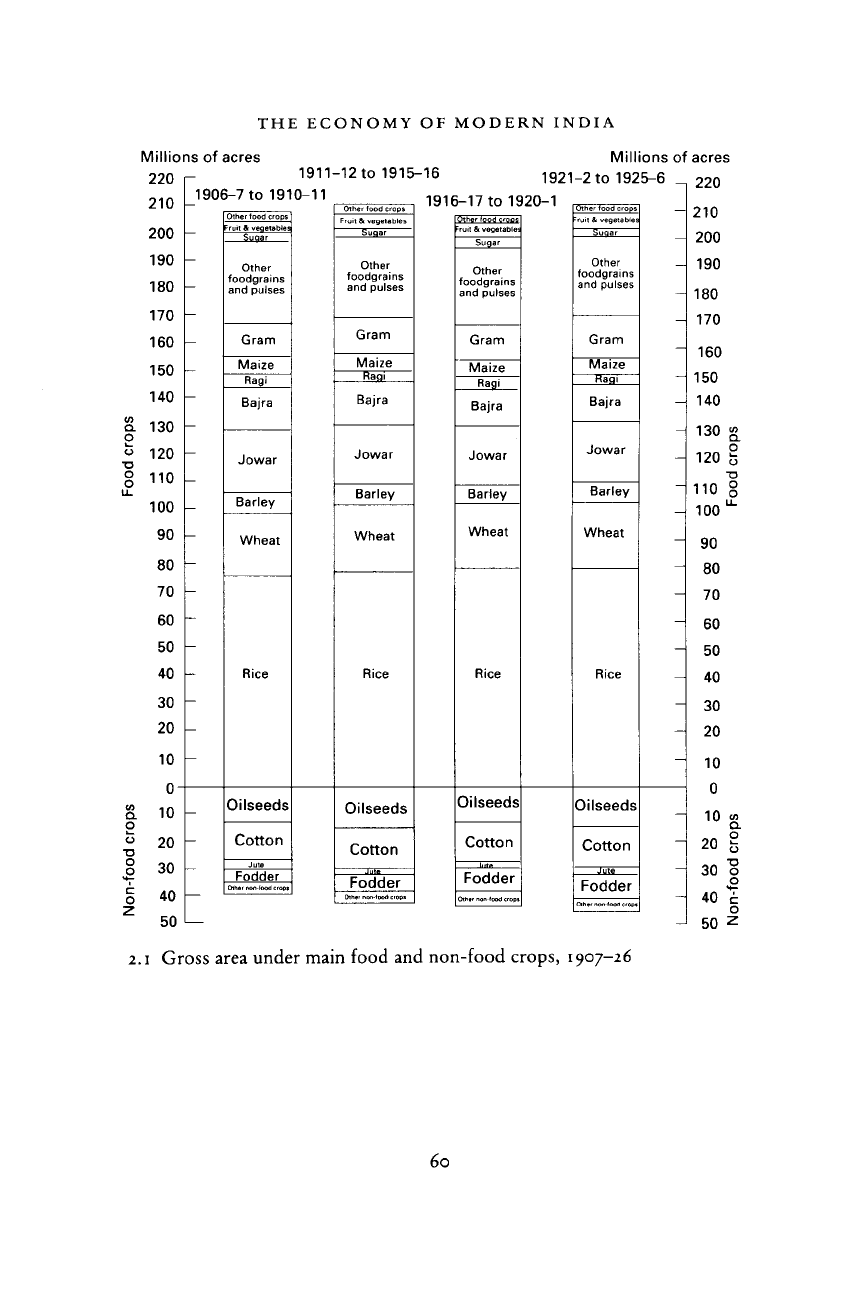
THE
ECONOMY OF
MODERN
INDIA
Millions
of
acres
220
Q.
O
O
"O
O
o
o.
o
-o
o
o
o
210
200
190
180
170
h
160
150
h
140
130
120
110
100
90
80
70
60
50
40
30 -
20 -
10
0
10
20
30
40
50
1911
1906-7
to
1910-11
Other
food
crops
Other
foodgrains
and
pulses
Gram
Maize
Ragi
Bajra
J o war
Barley
Wheat
Rice
Oilseeds
Cotton
Fodder
Other
non-food
crops
Millions
-12
to
1915-16
1921-2
to 1925-6
1916-17
to 1920-1
Other
food
crops
Fruit
&
vegetables
Sugar
Other
foodgrains
and
pulses
Gram
Maize
Bajra
J o war
Barley
Wheat
Rice
Oilseeds
Cotton
Fodder
Other
non-food
cr
:
ruit
&
vegetables
Sugar
Other
foodgrains
and
pulses
Gram
Maize
Ragi
Bajra
J o war
Barley
Wheat
Rice
Oilseeds
Cotton
Fodder
Other
non-food
crops
Other
food
crops
ruit
&
vegetables]
Suoar
Other
foodgrains
and
pulses
Gram
Maize
ZRägT
Bajra
Jowar
Barley
Wheat
Rice
Oilseeds
Cotton
Jute
Fodder
Other
non-food
cr
2.i Gross
area
under
main
food and
non-food
crops,
1907-26
of
acres
220
210
200
190
180
170
160
150
140
130
&
120
§
110
g
100
90
80
70
60
50
40
30
20
10
0
10
w
Q.
20 §
30 1
O
40 ¿
o
50 2
60
Cambridge Histories Online © Cambridge University Press, 2008

AGRICULTURE,
1860-195O
conditions could be a substitute for jowar) accounted for
13
per cent in
1891
and 18 per cent in
1940.
The relative sizes of the cultivated area
devoted
to each major crop in India in this period is shown in figure
2.I.
27
Whereas rice and millets were mostly consumed within the subsis-
tence economy, a good deal of wheat was grown either for export or
for
sale in urban markets. In
1891-5,
for example, about
17
per cent of
the wheat harvest was exported, as against 8 per cent of the rice harvest.
Before
1900 food prices in upland commercial centres were largely
determined by direct
trade
with individual port-cities. By the first
decade of the twentieth century, however, further improvements in
transportation networks and infrastructure had increased direct ship-
ments between the major regional centres considerably, creating a
coherent internal national market for the major agricultural crops,
marked by considerable convergence and integration of regional prices
for
bulk commodities.
28
International prices now influenced internal
markets for foodgrains more profoundly because of the
effect
of
imports of rice and wheat at the ports, while demand for 'inferior'
foodgrains such as millets were influenced by the possibilities of
substitution.
The
price history of the
fifty
years from
1880
to
1929
suggests
that
there were considerable profits to be made from the rural economy
during the period of commercial expansion. The pattern of the changes
and fluctuations in agricultural and non-agricultural prices is shown in
figure
2.2
by using index-numbers for exported and imported goods,
which
were largely determined by cash-crop exports and manufac-
tured consumer-goods imports. Price fluctuations for agricultural
crops in the domestic market are a more ambiguous indicator,
especially
before 1900, since sharp rises could be caused by falls in
yields
(resulting in shortages or famines) as
well
as by buoyant demand
in the urban or external economy. As one might expect, it appears
that
the prices of foodgrains consumed largely in the domestic subsistence
27
The acreage statistics on
which
this
chart is
based
are not
without
flaws,
especially
as
regards
double-cropped
and irrigated land. They are adequate for
giving
a general
impression
of the
division
of
land
among
particular crops, but
should
not be
used
as
evidence
of major
shifts
in
cultivation
patterns.
28
Michelle
McAlpin,
'Price
Movements
and Fluctuations in Economic Activity
(1960-
1947)',
CEHI
11,
ch. xi. The output
figures
used
in
these
calculations are taken from Blyn,
Agricultural
Trends
in
India,
1966.
61
Cambridge Histories Online © Cambridge University Press, 2008
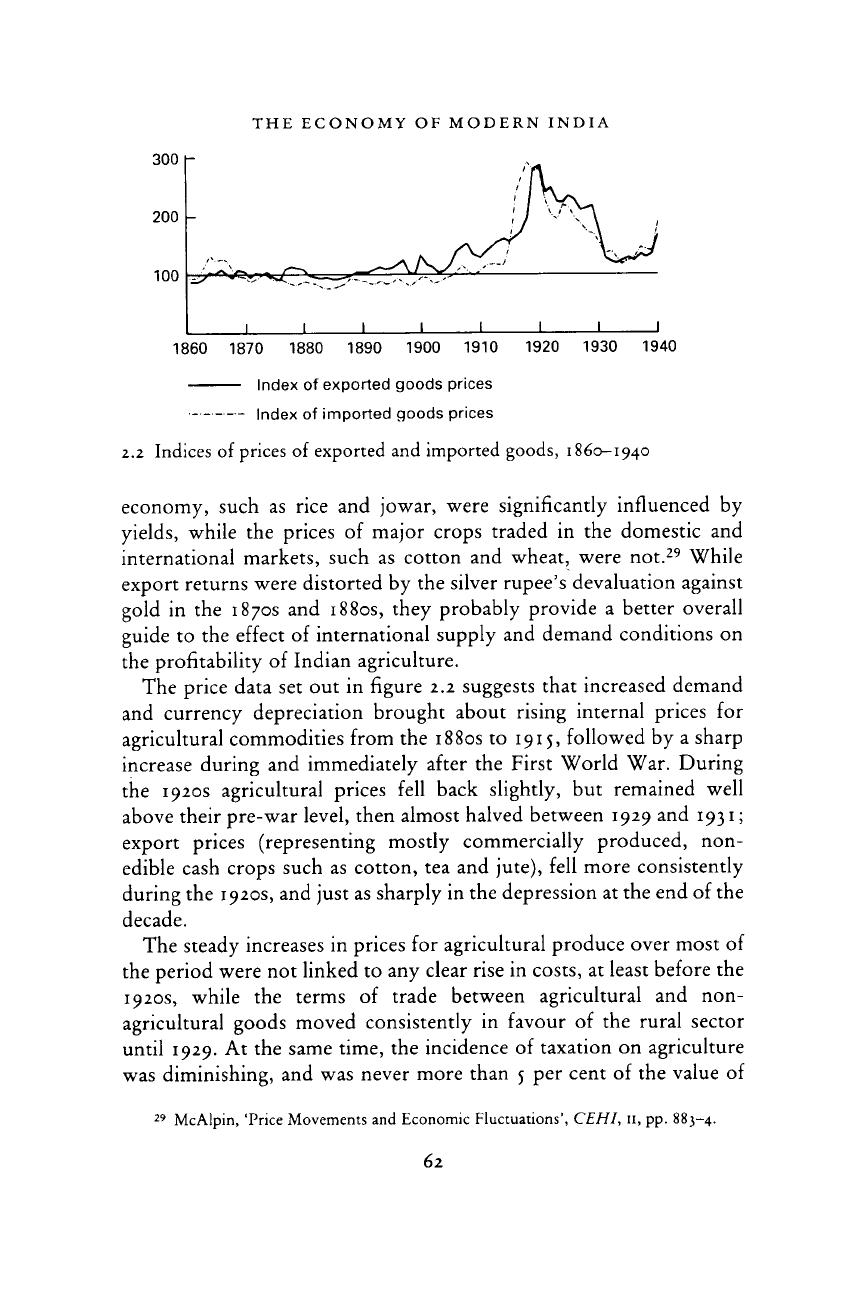
THE
ECONOMY
OF MODERN INDIA
300
h-
200
100
1860
1870 1880 1890 1900 1910 1920 1930 1940
Index of exported goods prices
Index of
imported
goods prices
2.2 Indices of prices of exported and
imported
goods, 1860-1940
economy,
such as rice and jowar, were significantly influenced by
yields,
while the prices of major crops
traded
in the domestic and
international markets, such as cotton and wheat, were not.
29
While
export
returns
were distorted by the silver rupee's devaluation against
gold
in the 1870s and 1880s, they probably provide a
better
overall
guide
to the
effect
of international supply and demand conditions on
the profitability of Indian agriculture.
The
price
data
set out in figure 2.2 suggests
that
increased demand
and currency depreciation brought about rising internal prices for
agricultural commodities from the 1880s to
1915,
followed
by a
sharp
increase during and immediately after the First World War. During
the 1920s agricultural prices
fell
back slightly, but remained
well
above
their pre-war
level,
then
almost halved between 1929 and 1931;
export prices (representing mostly commercially produced, non-
edible
cash crops such as cotton, tea and jute),
fell
more consistently
during the 1920s, and just as sharply in the depression at the end of the
decade.
The
steady increases in prices for agricultural produce over most of
the period were not linked to any clear rise in costs, at least before the
1920s,
while the
terms
of
trade
between agricultural and non-
agricultural goods moved consistently in favour of the
rural
sector
until 1929. At the same time, the incidence of taxation on agriculture
was
diminishing, and was never more
than
5 per cent of the value of
29
McAlpin,
Trice
Movements and Economic Fluctuations',
CEHI,
11,
pp.
883-4.
62
Cambridge Histories Online © Cambridge University Press, 2008
